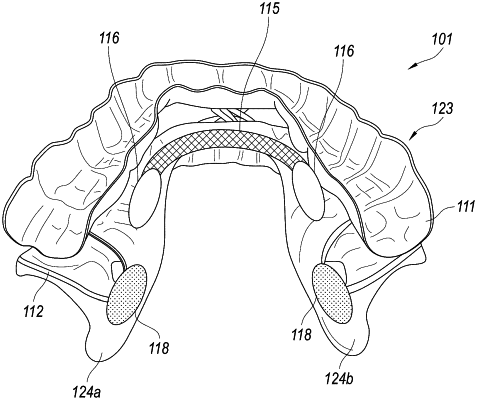| CPC A61N 1/3611 (2013.01) [A61N 1/0548 (2013.01); A61N 1/0558 (2013.01); A61N 1/36139 (2013.01); A61N 1/36153 (2013.01); A61N 1/36157 (2013.01); A61N 1/36171 (2013.01); A61N 1/36175 (2013.01); A61N 1/3787 (2013.01); A61N 1/37205 (2013.01); H02J 50/20 (2016.02)] | 30 Claims |

|
1. A patient treatment system, comprising:
a wearable device shaped to conform to at least a portion of a patient's anatomy, the wearable device carrying:
a rechargeable power storage device;
at least one wireless power transmission device coupled to the power storage device;
at least one sensor configured to detect at least one of a heart rate or a respiratory rate of the patient; and
first circuitry coupled to the power storage device, the at least one wireless power transmission device, and the at least one sensor, the first circuitry including a controller programmed with instructions that, when executed—
determine at least one of (1) a sleep state of the patient or (2) a patient airflow event, based at least partially on input from the at least one sensor, and
cause the at least one wireless power transmission device to transmit power based at least partially on at least one of the determined sleep state or the patient airflow event; and
a percutaneously implantable device having:
an electrode;
a housing carrying the electrode;
an anchor carried by the housing and positioned to secure the percutaneously implantable device proximate a medial branch of a hypoglossal nerve of the patient;
an electrode receiver device configured to receive power transmitted from the at least one wireless power transmission device;
a signal generator coupled to the electrode receiver device and the electrode to direct a signal to the electrode at a frequency in a range of 10 Hz to 300 Hz;
a charge storage device having a charge storage capacity of no more than 5 minutes; and
second circuitry coupled between the signal generator and the electrode to control the delivery of the signal to the electrode.
|